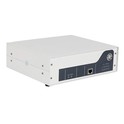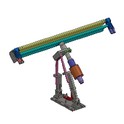In the realm of industrial cleaning and filtration, ultrasonic tank filters have emerged as a revolutionary solution, offering unparalleled efficiency and effectiveness. As a leading supplier of ultrasonic tank filters, I often encounter inquiries from customers regarding the regulations governing their use. In this blog post, I aim to delve into this topic, providing a comprehensive overview of the relevant regulations and their implications for users.
Understanding Ultrasonic Tank Filters
Before we explore the regulations, let's first understand what ultrasonic tank filters are and how they work. Ultrasonic tank filters are advanced filtration systems that utilize ultrasonic technology to enhance the cleaning and filtration process. These filters are typically installed in tanks or vessels containing liquids, such as water, oil, or chemicals, and are designed to remove contaminants, particles, and impurities from the liquid.
The ultrasonic technology employed in these filters generates high-frequency sound waves that create microscopic bubbles in the liquid. These bubbles implode upon reaching a certain size, producing intense shockwaves that dislodge and remove contaminants from the filter media and the tank walls. This process, known as cavitation, significantly improves the filtration efficiency and extends the lifespan of the filter.
Regulations Governing Ultrasonic Tank Filters
The use of ultrasonic tank filters is subject to various regulations and standards, which vary depending on the industry, application, and geographical location. These regulations are designed to ensure the safety, performance, and environmental compliance of the filters. Here are some of the key regulations that users need to be aware of:
1. Safety Regulations
Safety is of utmost importance when it comes to the use of ultrasonic tank filters. Many countries have specific safety regulations in place to protect workers and the environment from potential hazards associated with these filters. These regulations typically cover aspects such as electrical safety, mechanical safety, and chemical safety.
For example, in the United States, the Occupational Safety and Health Administration (OSHA) has established safety standards for the use of industrial equipment, including ultrasonic tank filters. These standards require employers to provide proper training to workers, ensure the installation and maintenance of equipment in accordance with manufacturer's instructions, and implement appropriate safety measures to prevent accidents and injuries.
2. Environmental Regulations
In addition to safety regulations, ultrasonic tank filters are also subject to environmental regulations. These regulations are aimed at minimizing the environmental impact of the filtration process, including the disposal of contaminants and the use of chemicals.
For instance, in the European Union, the Waste Framework Directive sets out the rules for the management of waste, including the disposal of contaminated filter media. The directive requires businesses to ensure that waste is properly classified, stored, and disposed of in accordance with environmental standards. Similarly, the Registration, Evaluation, Authorization, and Restriction of Chemicals (REACH) regulation regulates the use of chemicals in the EU, including those used in ultrasonic tank filters.
3. Performance Standards
To ensure the effectiveness and reliability of ultrasonic tank filters, there are also performance standards that manufacturers and users need to comply with. These standards define the minimum requirements for the performance, efficiency, and durability of the filters.
For example, the International Organization for Standardization (ISO) has developed a series of standards for filtration systems, including ultrasonic tank filters. These standards cover aspects such as filtration efficiency, flow rate, pressure drop, and particle size distribution. Compliance with these standards ensures that the filters meet the highest quality and performance requirements.
Implications for Users
The regulations governing the use of ultrasonic tank filters have several implications for users. Here are some of the key points that users need to consider:
1. Compliance Requirements
Users are responsible for ensuring that their ultrasonic tank filters comply with all relevant regulations and standards. This may involve obtaining appropriate certifications, conducting regular inspections and maintenance, and keeping accurate records of the filter's performance and usage.
2. Safety and Training
Safety should always be a top priority when using ultrasonic tank filters. Users need to provide proper training to workers on the safe operation and maintenance of the filters, including the use of personal protective equipment (PPE). They also need to implement appropriate safety measures to prevent accidents and injuries, such as installing emergency stop buttons and ensuring proper ventilation.
3. Environmental Impact
Users need to be aware of the environmental impact of the filtration process and take steps to minimize it. This may involve using environmentally friendly filter media, properly disposing of contaminants, and reducing the use of chemicals.


4. Performance and Efficiency
To ensure the optimal performance and efficiency of ultrasonic tank filters, users need to select the right filter for their application and follow the manufacturer's instructions for installation, operation, and maintenance. Regular monitoring and testing of the filter's performance can help identify any issues early on and ensure that the filter is functioning properly.
Our Commitment as a Supplier
As a supplier of ultrasonic tank filters, we are committed to providing our customers with high-quality products that comply with all relevant regulations and standards. We work closely with our customers to understand their specific needs and requirements and provide them with customized solutions that meet their expectations.
Our ultrasonic tank filters are designed and manufactured using the latest technology and highest quality materials, ensuring superior performance, reliability, and durability. We also offer comprehensive after-sales support, including installation, maintenance, and repair services, to ensure that our customers get the most out of their filters.
In addition, we stay up-to-date with the latest regulations and standards in the industry and ensure that our products are continuously improved and updated to meet the changing requirements of our customers. We believe that by providing our customers with safe, efficient, and environmentally friendly filtration solutions, we can help them achieve their business goals while also contributing to a sustainable future.
Conclusion
In conclusion, the use of ultrasonic tank filters is subject to various regulations and standards, which are designed to ensure the safety, performance, and environmental compliance of the filters. As a user, it is important to be aware of these regulations and take the necessary steps to ensure compliance. By doing so, you can not only protect your workers and the environment but also ensure the optimal performance and efficiency of your filtration system.
If you are interested in learning more about our ultrasonic tank filters or have any questions regarding the regulations governing their use, please do not hesitate to contact us. We would be happy to provide you with more information and assist you in selecting the right filter for your application.
References
- Occupational Safety and Health Administration (OSHA). (n.d.). Industrial Equipment Safety Standards. Retrieved from [OSHA Website]
- European Union. (n.d.). Waste Framework Directive. Retrieved from [EU Website]
- European Union. (n.d.). Registration, Evaluation, Authorization, and Restriction of Chemicals (REACH). Retrieved from [EU Website]
- International Organization for Standardization (ISO). (n.d.). Filtration System Standards. Retrieved from [ISO Website]
To explore our range of ultrasonic tank filters, visit Ultrasonic Tank Filter. For more information on our ultrasonic pipe filters, check out Ultrasonic Pipe Filter. If you're interested in discussing a potential purchase or have any questions, feel free to reach out for a procurement consultation.






